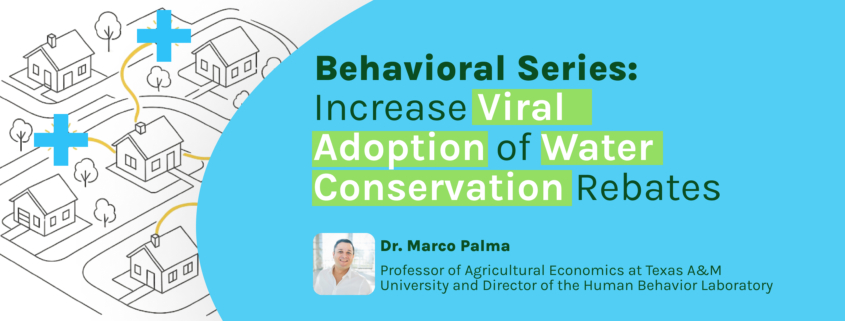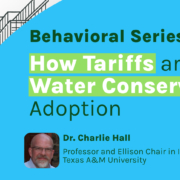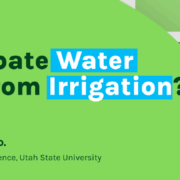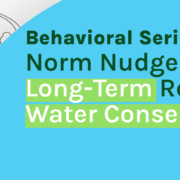How to Increase Viral Adoption of Water Conservation Rebates
Editorial Director: Steve Whitesell
Expert Reviewer: Dr Marco Palma
The most cost-effective way to expand irrigation savings isn’t by raising rebate amounts. It’s by designing programs that neighbors can see, copy, and celebrate.
Tactics that Create Visibility
-
- Yard signs with QR codes: “This lawn saves 30% more water. Scan to see how.”
- Neighborhood dashboards: Public maps or leaderboards showing water-use reductions.
- Community tours: Partner with HOAs or garden clubs to showcase upgraded systems.
- Social media posts: Sharing water savings on social media increases awareness.
Water conservation programs can achieve far greater impact by designing for spillover (or viral) adoption — by structuring irrigation upgrade programs so that one homeowner’s rebate sparks a wave of upgrades nearby.
Why It Matters
Even the best rebate programs hit participation ceilings. Most rebate programs don’t have a large enough budget to cover water conservation upgrades for every resident in their district.
To make a lasting impact, utilities must turn one upgraded yard into a neighborhood movement.
When a single irrigation upgrade triggers one or more actions nearby, that’s spillover adoption — and it’s one of the most cost-effective ways for utilities to scale savings.
Behavioral Expert on Conservation Virality
To better understand how behavioral science can accelerate community water savings, we engaged Dr. Marco Palma, Professor of Agricultural Economics and Director of the Human Behavior Laboratory at Texas A&M University.
Dr. Palma is a leading researcher in behavioral and experimental economics, neuroeconomics, and food economics, with over 100 peer-reviewed publications and $117 million in research funding from agencies including the USDA and NSF.
His research explores how human psychology, social norms, and visual cues influence real-world decisions — from food choices to sustainability behavior. In this piece, Dr. Palma shares insights on how utilities can apply those same behavioral triggers to design irrigation rebate programs that spread through neighborhoods like social trends — not mandates.
Create Spillover Adoption of Water Conservation
Data from the Metropolitan Water District of Southern California found that “for every 100 homes that converted their yards using a rebate, an additional 132 nearby homes were inspired to convert their own grass without receiving a rebate.”
This finding comes from a study titled “Quantifying the Multiplier Effect of Southern California’s Turf Removal Rebate Program with Time-Series Aerial Imagery” by Andrew Marx.
Why it happens:
Neighbors trust what they can see. A greener, efficient lawn serves as a silent, powerful endorsement.
“Human beings care about what others think of us. We have a natural tendency to belong,” said Dr. Marco Palma, Professor of Agricultural Economics at Texas A&M University. “Recent neuroscience shows that social rejection activates the same pain regions in the brain (Eisenberger & Lieberman, 2004). In classic experiments, people often conformed to group opinions — even when they were wrong — because belonging mattered more than accuracy.”
Dr. Palma added, “We are naturally competitive. This competitive environment provides an edge for people to take action, especially when the outcome is visible and confers social status.”
Takeaway: Every rebate is marketing — if it’s visible, local, and social. Create virality to change community behavior instead of just relying on one rebate.
Make Water Savings Visible
Spillover starts with visibility.
Homeowners are more likely to conserve when they see the results around them.
Programs like turf-replacement efforts in Las Vegas and Southern California were able to remove turf partly because the conservation behavior was visible and easy to compare.
“Visibility of the reward medium is crucial,” said Dr. Palma. “You can think of conservation as a form of conspicuous contribution. People don’t observe your income — they observe your purchases, your car, your lawn. In the same way, they must be able to see the social status and community pride that come from being conservation champions.”
Conclusion: Make conservation seen and celebrated — visibility turns private action into public pride.
Activate Social Proof
People are more likely to adopt when they see peers doing it.
The challenge: framing conservation as a majority behavior, not a fringe one.
“You want to create environments where most people are acting and being rewarded through social validation,” said Dr. Palma. “If only 10% are participating, don’t emphasize that number — highlight the total gallons saved or the urgency of joining in. People conform when there’s social status attached to belonging.”
How to trigger social proof:
- Send “neighbors like you” mailers highlighting nearby rebate participants.
- Share local stories via Nextdoor or community Facebook groups.
- Create a “Water Smart Neighborhood” badge for areas with high participation.
Conclusion: Social proof accelerates momentum — conservation becomes contagious when it becomes a source of community identity.
Simplify the Behavior Change
Even motivated homeowners hesitate when upgrades feel complicated.
“If it’s hard to do, people postpone it and eventually don’t do it,” said Dr. Palma. “They may have good intentions, but complexity creates resistance. That’s why nudges work — they rely on people doing nothing.”
Reduce friction with design:
- Pre-qualify contractors and list them by neighborhood.
- Offer tiered rebates for irrigation automation — easy, low-cost steps first.
- Bundle upgrades with smart scheduling apps or local hardware coupons.
Conclusion: Make it effortless to say yes. The easier it is to copy a success story, the faster the spillover spreads.
The Bottom Line
The next frontier in rebate design isn’t higher payouts — it’s higher visibility and easier imitation.
Every irrigation upgrade can inspire three more when people see, understand, and want to match the reward.
The mission now: Design for the ripple, not the rebate.
















